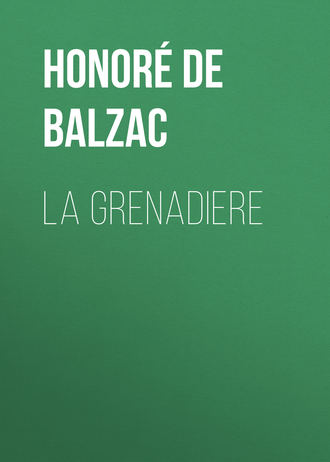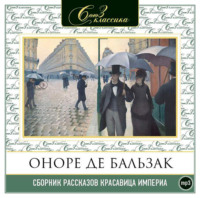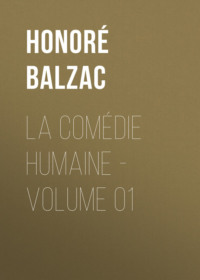 полная версия
полная версияLa Grenadiere

Honoré de Balzac
La Grenadiere
La Grenadiere is a little house on the right bank of the Loire as you go down stream, about a mile below the bridge of Tours. At this point the river, broad as a lake, and covered with scattered green islands, flows between two lines of cliff, where country houses built uniformly of white stone stand among their gardens and vineyards. The finest fruit in the world ripens there with a southern exposure. The patient toil of many generations has cut terraces in the cliff, so that the face of the rock reflects the rays of the sun, and the produce of hot climates may be grown out of doors in an artificially high temperature.
A church spire, rising out of one of the shallower dips in the line of cliffs, marks the little village of Saint-Cyr, to which the scattered houses all belong. And yet a little further the Choisille flows into the Loire, through a fertile valley cut in the long low downs.
La Grenadiere itself, half-way up the hillside, and about a hundred paces from the church, is one of those old-fashioned houses dating back some two or three hundred years, which you find in every picturesque spot in Touraine. A fissure in the rock affords convenient space for a flight of steps descending gradually to the “dike” – the local name for the embankment made at the foot of the cliffs to keep the Loire in its bed, and serve as a causeway for the highroad from Paris to Nantes. At the top of the steps a gate opens upon a narrow stony footpath between two terraces, for here the soil is banked up, and walls are built to prevent landslips. These earthworks, as it were, are crowned with trellises and espaliers, so that the steep path that lies at the foot of the upper wall is almost hidden by the trees that grow on the top of the lower, upon which it lies. The view of the river widens out before you at every step as you climb to the house.
At the end you come to a second gateway, a Gothic archway covered with simple ornament, now crumbling into ruin and overgrown with wildflowers – moss and ivy, wallflowers and pellitory. Every stone wall on the hillside is decked with this ineradicable plant-life, which springs up along the cracks afresh with new wreaths for every time of year.
The worm-eaten gate gives into a little garden, a strip of turf, a few trees, and a wilderness of flowers and rose bushes – a garden won from the rock on the highest terrace of all, with the dark, old balustrade along its edge. Opposite the gateway, a wooden summer-house stands against the neighboring wall, the posts are covered with jessamine and honeysuckle, vines and clematis.
The house itself stands in the middle of this highest garden, above a vine-covered flight of steps, with an arched doorway beneath that leads to vast cellars hollowed out in the rock. All about the dwelling trellised vines and pomegranate-trees (the grenadiers, which give the name to the little close) are growing out in the open air. The front of the house consists of two large windows on either side of a very rustic-looking house door, and three dormer windows in the roof – a slate roof with two gables, prodigiously high-pitched in proportion to the low ground-floor. The house walls are washed with yellow color; and door, and first-floor shutters, all the Venetian shutters of the attic windows, all are painted green.
Entering the house, you find yourself in a little lobby with a crooked staircase straight in front of you. It is a crazy wooden structure, the spiral balusters are brown with age, and the steps themselves take a new angle at every turn. The great old-fashioned paneled dining-room, floored with square white tiles from Chateau-Regnault, is on your right; to the left is the sitting-room, equally large, but here the walls are not paneled; they have been covered instead with a saffron-colored paper, bordered with green. The walnut-wood rafters are left visible, and the intervening spaces filled with a kind of white plaster.
The first story consists of two large whitewashed bedrooms with stone chimney-pieces, less elaborately carved than those in the rooms beneath. Every door and window is on the south side of the house, save a single door to the north, contrived behind the staircase to give access to the vineyard. Against the western wall stands a supplementary timber-framed structure, all the woodwork exposed to the weather being fledged with slates, so that the walls are checkered with bluish lines. This shed (for it is little more) is the kitchen of the establishment. You can pass from it into the house without going outside; but, nevertheless, it boasts an entrance door of its own, and a short flight of steps that brings you to a deep well, and a very rustical-looking pump, half hidden by water-plants and savin bushes and tall grasses. The kitchen is a modern addition, proving beyond doubt that La Grenadiere was originally nothing but a simple vendangeoir – a vintage-house belonging to townsfolk in Tours, from which Saint-Cyr is separated by the vast river-bed of the Loire. The owners only came over for the day for a picnic, or at the vintage-time, sending provisions across in the morning, and scarcely ever spent the night there except during the grape harvest; but the English settled down on Touraine like a cloud of locusts, and La Grenadiere must, of course, be completed if it was to find tenants. Luckily, however, this recent appendage is hidden from sight by the first two trees of a lime-tree avenue planted in a gully below the vineyards.
There are only two acres of vineyard at most, the ground rising at the back of the house so steeply that it is no very easy matter to scramble up among the vines. The slope, covered with green trailing shoots, ends within about five feet of the house wall in a ditch-like passage always damp and cold and full of strong growing green things, fed by the drainage of the highly cultivated ground above, for rainy weather washes down the manure into the garden on the terrace.
A vinedresser’s cottage also leans against the western gable, and is in some sort a continuation of the kitchen. Stone walls or espaliers surround the property, and all sorts of fruit-trees are planted among the vines; in short, not an inch of this precious soil is wasted. If by chance man overlooks some dry cranny in the rocks, Nature puts in a fig-tree, or sows wildflowers or strawberries in sheltered nooks among the stones.
Nowhere else in all the world will you find a human dwelling so humble and yet so imposing, so rich in fruit, and fragrant scents, and wide views of country. Here is a miniature Touraine in the heart of Touraine – all its flowers and fruits and all the characteristic beauty of the land are fully represented. Here are grapes of every district, figs and peaches and pears of every kind; melons are grown out of doors as easily as licorice plants, Spanish broom, Italian oleanders, and jessamines from the Azores. The Loire lies at your feet. You look down from the terrace upon the ever-changing river nearly two hundred feet below; and in the evening the breeze brings a fresh scent of the sea, with the fragrance of far-off flowers gathered upon its way. Some cloud wandering in space, changing its color and form at every moment as it crosses the pure blue of the sky, can alter every detail in the widespread wonderful landscape in a thousand ways, from every point of view. The eye embraces first of all the south bank of the Loire, stretching away as far as Amboise, then Tours with its suburbs and buildings, and the Plessis rising out of the fertile plain; further away, between Vouvray and Saint-Symphorien, you see a sort of crescent of gray cliff full of sunny vineyards; the only limits to your view are the low, rich hills along the Cher, a bluish line of horizon broken by many a chateau and the wooded masses of many a park. Out to the west you lose yourself in the immense river, where vessels come and go, spreading their white sails to the winds which seldom fail them in the wide Loire basin. A prince might build a summer palace at La Grenadiere, but certainly it will always be the home of a poet’s desire, and the sweetest of retreats for two young lovers – for this vintage house, which belongs to a substantial burgess of Tours, has charms for every imagination, for the humblest and dullest as well as for the most impassioned and lofty. No one can dwell there without feeling that happiness is in the air, without a glimpse of all that is meant by a peaceful life without care or ambition. There is that in the air and the sound of the river that sets you dreaming; the sands have a language, and are joyous or dreary, golden or wan; and the owner of the vineyard may sit motionless amid perennial flowers and tempting fruit, and feel all the stir of the world about him.
If an Englishman takes the house for the summer, he is asked a thousand francs for six months, the produce of the vineyard not included. If the tenant wishes for the orchard fruit, the rent is doubled; for the vintage, it is doubled again. What can La Grenadiere be worth, you wonder; La Grenadiere, with its stone staircase, its beaten path and triple terrace, its two acres of vineyard, its flowering roses about the balustrades, its worn steps, well-head, rampant clematis, and cosmopolitan trees? It is idle to make a bid! La Grenadiere will never be in the market; it was brought once and sold, but that was in 1690; and the owner parted with it for forty thousand francs, reluctant as any Arab of the desert to relinquish a favorite horse. Since then it has remained in the same family, its pride, its patrimonial jewel, its Regent diamond. “While you behold, you have and hold,” says the bard. And from La Grenadiere you behold three valleys of Touraine and the cathedral towers aloft in air like a bit of filigree work. How can one pay for such treasures? Could one ever pay for the health recovered there under the linden-trees?
In the spring of one of the brightest years of the Restoration, a lady with her housekeeper and her two children (the oldest a boy thirteen years old, the youngest apparently about eight) came to Tours to look for a house. She saw La Grenadiere and took it. Perhaps the distance from the town was an inducement to live there.
She made a bedroom of the drawing-room, gave the children the two rooms above, and the housekeeper slept in a closet behind the kitchen. The dining-room was sitting-room and drawing-room all in one for the little family. The house was furnished very simply but tastefully; there was nothing superfluous in it, and no trace of luxury. The walnut-wood furniture chosen by the stranger lady was perfectly plain, and the whole charm of the house consisted in its neatness and harmony with its surroundings.
It was rather difficult, therefore, to say whether the strange lady (Mme. Willemsens, as she styled herself) belonged to the upper middle or higher classes, or to an equivocal, unclassified feminine species. Her plain dress gave rise to the most contradictory suppositions, but her manners might be held to confirm those favorable to her. She had not lived at Saint-Cyr, moreover, for very long before her reserve excited the curiosity of idle people, who always, and especially in the country, watch anybody or anything that promises to bring some interest into their narrow lives.
Mme. Willemsens was rather tall; she was thin and slender, but delicately shaped. She had pretty feet, more remarkable for the grace of her instep and ankle than for the more ordinary merit of slenderness; her gloved hands, too, were shapely. There were flitting patches of deep red in a pale face, which must have been fresh and softly colored once. Premature wrinkles had withered the delicately modeled forehead beneath the coronet of soft, well-set chestnut hair, invariably wound about her head in two plaits, a girlish coiffure which suited the melancholy face. There was a deceptive look of calm in the dark eyes, with the hollow, shadowy circles about them; sometimes, when she was off her guard, their expression told of secret anguish. The oval of her face was somewhat long; but happiness and health had perhaps filled and perfected the outlines. A forced smile, full of quiet sadness, hovered continually on her pale lips; but when the children, who were always with her, looked up at their mother, or asked one of the incessant idle questions which convey so much to a mother’s ears, then the smile brightened, and expressed the joys of a mother’s love. Her gait was slow and dignified. Her dress never varied; evidently she had made up her mind to think no more of her toilette, and to forget a world by which she meant no doubt to be forgotten. She wore a long, black gown, confined at the waist by a watered-silk ribbon, and by way of scarf a lawn handkerchief with a broad hem, the two ends passed carelessly through her waistband. The instinct of dress showed itself in that she was daintily shod, and gray silk stockings carried out the suggestion of mourning in this unvarying costume. Lastly, she always wore a bonnet after the English fashion, always of the same shape and the same gray material, and a black veil. Her health apparently was extremely weak; she looked very ill. On fine evenings she would take her only walk, down to the bridge of Tours, bringing the two children with her to breathe the fresh, cool air along the Loire, and to watch the sunset effects on a landscape as wide as the Bay of Naples or the Lake of Geneva.
During the whole time of her stay at La Grenadiere she went but twice into Tours; once to call on the headmaster of the school, to ask him to give her the names of the best masters of Latin, drawing, and mathematics; and a second time to make arrangements for the children’s lessons. But her appearance on the bridge of an evening, once or twice a week, was quite enough to excite the interest of almost all the inhabitants of Tours, who make a regular promenade of the bridge. Still, in spite of a kind of spy system, by which no harm is meant, a provincial habit bred of want of occupation and the restless inquisitiveness of the principal society, nothing was known for certain of the newcomer’s rank, fortune, or real condition. Only, the owner of La Grenadiere told one or two of his friends that the name under which the stranger had signed the lease (her real name, therefore, in all probability) was Augusta Willemsens, Countess of Brandon. This, of course, must be her husband’s name. Events, which will be narrated in their place, confirmed this revelation; but it went no further than the little world of men of business known to the landlord.
So Madame Willemsens was a continual mystery to people of condition. Hers was no ordinary nature; her manners were simple and delightfully natural, the tones of her voice were divinely sweet, – this was all that she suffered others to discover. In her complete seclusion, her sadness, her beauty so passionately obscured, nay, almost blighted, there was so much to charm, that several young gentlemen fell in love; but the more sincere the lover, the more timid he became; and besides, the lady inspired awe, and it was a difficult matter to find enough courage to speak to her. Finally, if a few of the bolder sort wrote to her, their letters must have been burned unread. It was Mme. Willemsens’ practice to throw all the letters which she received into the fire, as if she meant that the time spent in Touraine should be untroubled by any outside cares even of the slightest. She might have come to the enchanting retreat to give herself up wholly to the joy of living.
The three masters whose presence was allowed at La Grenadiere spoke with something like admiring reverence of the touching picture that they saw there of the close, unclouded intimacy of the life led by this woman and the children.
The two little boys also aroused no small interest. Mothers could not see them without a feeling of envy. Both children were like Mme. Willemsens, who was, in fact, their mother. They had the transparent complexion and bright color, the clear, liquid eyes, the long lashes, the fresh outlines, the dazzling characteristics of childish beauty.
The elder, Louis-Gaston, had dark hair and fearless eyes. Everything about him spoke as plainly of robust, physical health as his broad, high brow, with its gracious curves, spoke of energy of character. He was quick and alert in his movements, and strong of limb, without a trace of awkwardness. Nothing took him unawares, and he seemed to think about everything that he saw.
Marie-Gaston, the other child, had hair that was almost golden, though a lock here and there had deepened to the mother’s chestnut tint. Marie-Gaston was slender; he had the delicate features and the subtle grace so charming in Mme. Willemsens. He did not look strong. There was a gentle look in his gray eyes; his face was pale, there was something feminine about the child. He still wore his hair in long, wavy curls, and his mother would not have him give up embroidered collars, and little jackets fastened with frogs and spindle-shaped buttons; evidently she took a thoroughly feminine pleasure in the costume, a source of as much interest to the mother as to the child. The elder boy’s plain white collar, turned down over a closely fitting jacket, made a contrast with his brother’s clothing, but the color and material were the same; the two brothers were otherwise dressed alike, and looked alike.
No one could see them without feeling touched by the way in which Louis took care of Marie. There was an almost fatherly look in the older boy’s eyes; and Marie, child though he was, seemed to be full of gratitude to Louis. They were like two buds, scarcely separated from the stem that bore them, swayed by the same breeze, lying in the same ray of sunlight; but the one was a brightly colored flower, the other somewhat bleached and pale. At a glance, a word, an inflection in their mother’s voice, they grew heedful, turned to look at her and listened, and did at once what they were bidden, or asked, or recommended to do. Mme. Willemsens had so accustomed them to understand her wishes and desires, that the three seemed to have their thoughts in common. When they went for a walk, and the children, absorbed in their play, ran away to gather a flower or to look at some insect, she watched them with such deep tenderness in her eyes, that the most indifferent passer-by would feel moved, and stop and smile at the children, and give the mother a glance of friendly greeting. Who would not have admired the dainty neatness of their dress, their sweet, childish voices, the grace of their movements, the promise in their faces, the innate something that told of careful training from the cradle? They seemed as if they had never shed tears nor wailed like other children. Their mother knew, as it were, by electrically swift intuition, the desires and the pains which she anticipated and relieved. She seemed to dread a complaint from one of them more than the loss of her soul. Everything in her children did honor to their mother’s training. Their threefold life, seemingly one life, called up vague, fond thoughts; it was like a vision of the dreamed-of bliss of a better world. And the three, so attuned to each other, lived in truth such a life as one might picture for them at first sight – the ordered, simple, and regular life best suited for a child’s education.
Both children rose an hour after daybreak and repeated a short prayer, a habit learned in their babyhood. For seven years the sincere petition had been put up every morning on their mother’s bed, and begun and ended by a kiss. Then the two brothers went through their morning toilet as scrupulously as any pretty woman; doubtless they had been trained in habits of minute attention to the person, so necessary to health of body and mind, habits in some sort conducive to a sense of wellbeing. Conscientiously they went through their duties, so afraid were they lest their mother should say when she kissed them at breakfast-time, “My darling children, where can you have been to have such black finger-nails already?” Then the two went out into the garden and shook off the dreams of the night in the morning air and dew, until sweeping and dusting operations were completed, and they could learn their lessons in the sitting-room until their mother joined them. But although it was understood that they must not go to their mother’s room before a certain hour, they peeped in at the door continually; and these morning inroads, made in defiance of the original compact, were delicious moments for all three. Marie sprang upon the bed to put his arms around his idolized mother, and Louis, kneeling by the pillow, took her hand in his. Then came inquiries, anxious as a lover’s, followed by angelic laughter, passionate childish kisses, eloquent silences, lisping words, and the little ones’ stories interrupted and resumed by a kiss, stories seldom finished, though the listener’s interest never failed.
“Have you been industrious?” their mother would ask, but in tones so sweet and so kindly that she seemed ready to pity laziness as a misfortune, and to glance through tears at the child who was satisfied with himself.
She knew that the thought of pleasing her put energy into the children’s work; and they knew that their mother lived for them, and that all her thoughts and her time were given to them. A wonderful instinct, neither selfishness nor reason, perhaps the first innocent beginnings of sentiment teaches children to know whether or not they are the first and sole thought, to find out those who love to think of them and for them. If you really love children, the dear little ones, with open hearts and unerring sense of justice, are marvelously ready to respond to love. Their love knows passion and jealousy and the most gracious delicacy of feeling; they find the tenderest words of expression; they trust you – put an entire belief in you. Perhaps there are no undutiful children without undutiful mothers, for a child’s affection is always in proportion to the affection that it receives – in early care, in the first words that it hears, in the response of the eyes to which a child first looks for love and life. All these things draw them closer to the mother or drive them apart. God lays the child under the mother’s heart, that she may learn that for a long time to come her heart must be its home. And yet – there are mothers cruelly slighted, mothers whose sublime, pathetic tenderness meets only a harsh return, a hideous ingratitude which shows how difficult it is to lay down hard-and-fast rules in matters of feeling.
Here, not one of all the thousand heart ties that bind child and mother had been broken. The three were alone in the world; they lived one life, a life of close sympathy. If Mme. Willemsens was silent in the morning, Louis and Marie would not speak, respecting everything in her, even those thoughts which they did not share. But the older boy, with a precocious power of thought, would not rest satisfied with his mother’s assertion that she was perfectly well. He scanned her face with uneasy forebodings; the exact danger he did not know, but dimly he felt it threatening in those purple rings about her eyes, in the deepening hollows under them, and the feverish red that deepened in her face. If Marie’s play began to tire her, his sensitive tact was quick to discover this, and he would call to his brother:
“Come, Marie! let us run in to breakfast, I am hungry!”
But when they reached the door, he would look back to catch the expression on his mother’s face. She still could find a smile for him, nay, often there were tears in her eyes when some little thing revealed her child’s exquisite feeling, a too early comprehension of sorrow.
Mme. Willemsens dressed during the children’s early breakfast and game of play; she was coquettish for her darlings; she wished to be pleasing in their eyes; for them she would fain be in all things lovely, a gracious vision, with the charm of some sweet perfume of which one can never have enough.
She was always dressed in time to hear their lessons, which lasted from ten till three, with an interval at noon for lunch, the three taking the meal together in the summer-house. After lunch the children played for an hour, while she – poor woman and happy mother – lay on a long sofa in the summer-house, so placed that she could look out over the soft, ever-changing country of Touraine, a land that you learn to see afresh in all the thousand chance effects produced by daylight and sky and the time of year.








